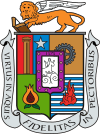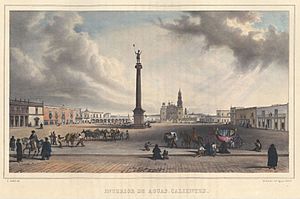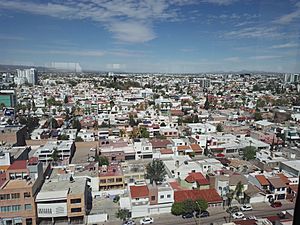Aguascalientes (city) facts for kids
Quick facts for kids
Aguascalientes
|
||
|---|---|---|
|
City
|
||
| Ciudad de Aguascalientes City of Aguascalientes |
||
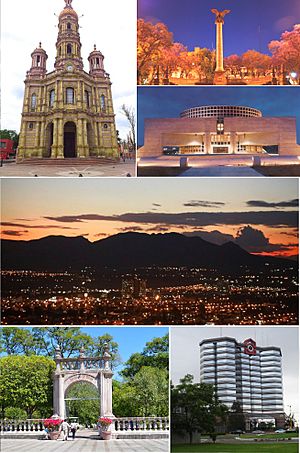
Clockwise from top: San Antonio de Padua Church, La Exedra (main square), Aguascalientes Opera House, Cerro del Muerto, Plaza Bosques Tower and the San Marcos Park.
|
||
|
||
| Nickname(s):
Spanish: Ciudad de la gente buena
(City of the good people) |
||
| Motto(s):
Latin: Virtus in Aquis, Fidelitas in Pectoribus
(Virtue in the Water, Fidelity in the Heart) |
||

Location of Aguascalientes within the state
|
||
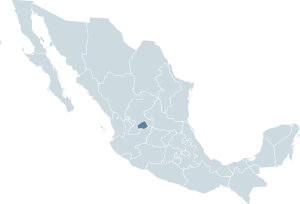
Location of the state of Aguascalientes
|
||
| Country | Mexico | |
| State | Aguascalientes | |
| Municipality | Aguascalientes | |
| Founded | October 22, 1575 | |
| Founded as | Villa de Nuestra Señora de la Asunción de las Aguas Calientes | |
| Founded by | Juan de Montoro Rodríguez Jerónimo de Orozco |
|
| Area | ||
| • City | 385 km2 (149 sq mi) | |
| Elevation | 1,888 m (6,194 ft) | |
| Population
(2020)
|
||
| • City | 948,990 | |
| • Density | 2,465/km2 (6,384/sq mi) | |
| • Metro | 1,225,432 | |
| Demonyms | hidrocálido, aguascalentense | |
| GDP (PPP, constant 2015 values) | ||
| • Year | 2023 | |
| • Total (Metro) | $29.0 billion | |
| • Per capita | $24,900 | |
| Time zone | UTC−6 (CST) | |
| Postal code |
20000-20999
|
|
| Area code(s) | 449 | |
| Federal Routes | ||
| Website | http://www.ags.gob.mx | |
Aguascalientes (pronounced ah-gwas-kah-LYEN-tes) is a cool city in Mexico. Its name means "hot waters" in Spanish, because of the many natural hot springs found there. It's the capital of the state of the same name and the biggest city in the area. About 948,990 people live here, and if you count the nearby towns, it's over 1.2 million!
This city was founded a long time ago, on October 22, 1575, by Spanish families. They named it Villa de Nuestra Señora de la Asunción de las Aguas Calientes, which means "Village of Our Lady of the Assumption of the Hot Waters." It was an important stop on the "Silver Route" for trading. In 1835, Aguascalientes became the capital of a new territory. Later, it became a state capital in 1857.
Aguascalientes is known for its history in farming, mining, and making textiles and trains. Today, it's a modern city that attracts big companies, especially in cars and electronics. For example, Nissan has two large car factories here. This has brought many Japanese people to live in the city. Aguascalientes is also famous for the San Marcos Fair, which is the biggest fair in Mexico!
Contents
History of Aguascalientes
The city of Aguascalientes was started on October 22, 1575. Juan de Montoro and his family, along with other families, founded it. It was first meant to be a small army outpost and a rest stop. This stop was between the cities of Zacatecas and Lagos de Moreno. Its main purpose was to protect silver being transported to Mexico City from the Chichimeca people. Even though the founders didn't think it would become a big city, it grew a lot. It became the capital of a new state in 1835, after separating from Zacatecas.
Old Neighborhoods of the City
The historic center of Aguascalientes grew from four main neighborhoods.
Barrio del Encino: The Oldest Area
The oldest neighborhood is the Barrio del Encino. It's even older than Aguascalientes itself! It was founded in 1565. This area was first called Triana, just like a neighborhood in Seville, Spain. The Barrio del Encino has a beautiful church called the Spanish: Templo del Señor del Encino. It was built between 1773 and 1796. A special religious statue, the Spanish: Cristo Negro del Encino (Black Christ of the Live Oak), is very important here. Next to the church, you can find a colonial square and the José Guadalupe Posada Museum. These are popular places to visit.
Barrio de San Marcos: Home of the Fair
The second neighborhood is the Barrio de San Marcos. It started in the early 1600s as a place for native people to live outside the village of Aguascalientes. They built a simple hospital and a chapel. This chapel was later replaced by the Spanish: Templo de San Marcos, finished in 1763. This church is the main spiritual center for the famous Feria Nacional de San Marcos.
Barrio de Guadalupe: Trading and Pottery
The third neighborhood is the Barrio de Guadalupe. It began in the late 1700s with shops and trading posts. These were along the road leading to Jalpa and Zacatecas. The neighborhood's famous Spanish: Templo de Guadalupe was built between 1767 and 1789. It's known for its beautiful Baroque front and its dome covered with Talavera tiles. This area grew quickly, especially after a big metal foundry was built nearby.
Barrio de la Salud: The Health Neighborhood
The last original neighborhood is the Barrio de la Salud. It started in the late 1700s with a small chapel and a cemetery. This was to help with sicknesses that affected the area. People who dug graves settled nearby, and others started fruit orchards. Even though the orchards are mostly gone now, you can still see clues about the neighborhood's past. For example, the streets are a bit mixed up, following old irrigation paths. Also, most homes are simple, single-story houses, showing it was a working-class area.
A fifth neighborhood, the Barrio de la Estación, is named after the central train station. It's newer, mostly built in the late 1800s. Even though it's very important to Aguascalientes' history, it's not one of the city's original old neighborhoods.
Geography and Climate
Aguascalientes is located in North-Central Mexico. It sits in a valley on the central Mexican plateau. The city is about 1880 meters (6,168 feet) above sea level.
Climate of Aguascalientes
Aguascalientes has a semi-arid climate. This means it's generally dry, but it does get rain. Most of the rain falls from June to September.
| Climate data for Aguascalientes (1951–2010, extremes 1947–2024) | |||||||||||||
|---|---|---|---|---|---|---|---|---|---|---|---|---|---|
| Month | Jan | Feb | Mar | Apr | May | Jun | Jul | Aug | Sep | Oct | Nov | Dec | Year |
| Record high °C (°F) | 29.5 (85.1) |
32.2 (90.0) |
34.0 (93.2) |
38.5 (101.3) |
39.5 (103.1) |
40.0 (104.0) |
36.0 (96.8) |
39.5 (103.1) |
36.0 (96.8) |
32.0 (89.6) |
31.0 (87.8) |
30.0 (86.0) |
40.0 (104.0) |
| Mean daily maximum °C (°F) | 22.3 (72.1) |
24.0 (75.2) |
26.5 (79.7) |
29.0 (84.2) |
30.7 (87.3) |
29.5 (85.1) |
27.3 (81.1) |
27.2 (81.0) |
26.3 (79.3) |
25.7 (78.3) |
24.6 (76.3) |
22.5 (72.5) |
26.3 (79.3) |
| Daily mean °C (°F) | 13.4 (56.1) |
14.9 (58.8) |
17.5 (63.5) |
20.3 (68.5) |
22.4 (72.3) |
22.5 (72.5) |
20.9 (69.6) |
20.8 (69.4) |
20.1 (68.2) |
18.5 (65.3) |
16.0 (60.8) |
13.9 (57.0) |
18.4 (65.1) |
| Mean daily minimum °C (°F) | 4.5 (40.1) |
5.9 (42.6) |
8.5 (47.3) |
11.5 (52.7) |
14.1 (57.4) |
15.4 (59.7) |
14.6 (58.3) |
14.5 (58.1) |
13.9 (57.0) |
11.2 (52.2) |
7.4 (45.3) |
5.4 (41.7) |
10.6 (51.1) |
| Record low °C (°F) | −6.0 (21.2) |
−7.0 (19.4) |
−1.0 (30.2) |
1.0 (33.8) |
4.5 (40.1) |
6.0 (42.8) |
6.5 (43.7) |
9.0 (48.2) |
5.0 (41.0) |
0.0 (32.0) |
−5.5 (22.1) |
−5.0 (23.0) |
−7.0 (19.4) |
| Average precipitation mm (inches) | 14.1 (0.56) |
9.5 (0.37) |
4.3 (0.17) |
8.8 (0.35) |
17.9 (0.70) |
88.1 (3.47) |
119.9 (4.72) |
120.4 (4.74) |
90.1 (3.55) |
35.4 (1.39) |
10.2 (0.40) |
11.8 (0.46) |
530.5 (20.89) |
| Average precipitation days (≥ 0.1 mm) | 2.4 | 1.5 | 1.0 | 1.6 | 3.6 | 9.7 | 13.5 | 13.2 | 9.5 | 4.9 | 1.6 | 2.2 | 64.7 |
| Average relative humidity (%) | 50.7 | 46.7 | 39.1 | 39.4 | 42.4 | 53.1 | 60.1 | 59.2 | 60.6 | 58.4 | 53.2 | 52.8 | 51.3 |
| Mean monthly sunshine hours | 231.7 | 243.3 | 273.1 | 267.6 | 267.3 | 218.3 | 203.7 | 229.7 | 202.9 | 230.4 | 247.1 | 223.6 | 2,838.7 |
| Source 1: Servicio Meteorológico Nacional, World Meteorological Organization (relative humidity and sun 1981–2010) | |||||||||||||
| Source 2: Colegio de Postgraduados | |||||||||||||
What's in a Name? Etymology
The name Aguascalientes comes from the Spanish words Spanish: aguas calientes. This means 'hot waters' or, more accurately, 'hot springs'. The city was given this name because of the many hot springs found there when it was first settled. These hot springs are still used today in spas and even for homes. People from Aguascalientes are sometimes called Spanish: hidrocálidos, which means "hydrothermal people."
Population and Growth: Demographics
| Historical population | ||
|---|---|---|
| Year | Pop. | ±% |
| 2010 | 797,010 | — |
| 2015 | 877,190 | +10.1% |
| 2020 | 948,990 | +8.2% |
In 2020, the city of Aguascalientes had a population of 948,990 people. If you include the nearby towns of Jesús María and San Francisco de los Romo, the total population of the metropolitan area was about 1,225,432.
Aguascalientes City is one of the fastest-growing cities in Mexico. It is also one of the largest metropolitan areas in the country by population.
Economy and Industry
Aguascalientes is a major center for making cars. It has two large Nissan factories, which are very important outside of Japan. These factories make popular car models like the Sentra and the Versa. Most of Mexico's Nissan cars are made right here. Because of these factories, many Japanese people live in the city.
Other big companies also have operations in Aguascalientes. Texas Instruments has a plant that makes electronic circuits. Sensata Technologies makes sensors for cars and other uses. Flextronics is another electronics company here. There are also companies that work in robotics, like FANUC Robotics.
Getting Around: Transportation
Biking in the City: Cycling
The city is building a network of green bicycle paths. These "greenways" are designed to make it easy, safe, and fun to ride bikes across the city.
Roads and Highways
Aguascalientes has a big network of roads. These roads connect different parts of the city and link to other cities. The city was planned carefully, with rules for how it should grow since 1936. It has three main highway loops around it. The first and second loops have special bridges and tunnels to help traffic flow smoothly.
Flying In: Airport
The Lic. Jesús Terán Peredo International Airport serves Aguascalientes. You can find daily direct flights to and from cities like Los Angeles, Dallas, Houston, and Chicago. There are also flights to other cities within Mexico.
Culture and Fun: Recreation

Aguascalientes hosts the biggest festival in Mexico, the San Marcos Fair. This huge event happens from mid-April to early May. It started in the San Marcos church and its beautiful garden. Now, it covers a massive area with:
- Exhibition spaces
- Bullrings
- Nightclubs
- Theaters
- Performance stages
- Theme parks
- Hotels
- Convention centers
The fair attracts almost 7 million visitors every year!
The old part of the city centers around downtown and its four original neighborhoods. A famous building here is the Baroque Government Palace. It was built in 1664 from red volcanic stone and is known for its one hundred arches. The impressive Baroque Cathedral, started in 1575, is the oldest building in the city. In the main square, a tall column from colonial times now has a sculpture celebrating Mexican independence.
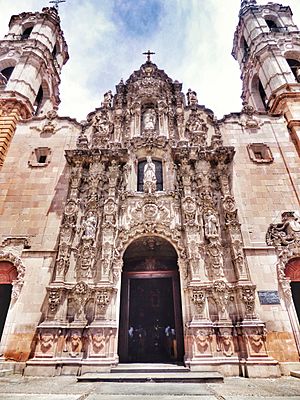
Neighborhoods and Traditions
The city of Aguascalientes has four main traditional neighborhoods that grew around the central Plaza de la Patria: Guadalupe, San Marcos, El Encino, and La Estación.
Guadalupe Neighborhood
The Guadalupe neighborhood is known for its pottery. Its main point is the local church, the Templo de Guadalupe. This important church, built in the late 1700s, has a beautiful Baroque front and a large dome covered in traditional talavera tiles. Inside, you can see many flower and angel designs.
San Marcos Neighborhood
Next is San Marcos, founded in 1604. This area now hosts the famous San Marcos Fair in springtime. You can visit the San Marcos Gardens, a green space with many paths and trees. Poets, artists, and couples often visit these gardens. Right in front of the gardens is the Baroque San Marcos Temple, with its shiny tiled dome.
La Estación Neighborhood
Finally, the neighborhood of La Estación gets its name from the old railway station. This station, opened in 1911, is a historical treasure of Aguascalientes.
Museums and Art
Aguascalientes' historic downtown has several museums:
- The Aguascalientes Museum (Spanish: Museo de Aguascalientes) is the city's art museum. It's in a classical-style building.
- The Guadalupe Posada Museum (Spanish: Museo Guadalupe Posada) is in the historic Triana neighborhood. It shows the life and work of the famous artist José Guadalupe Posada.
- The State History Museum is in a beautiful Art Nouveau mansion. It has a fancy patio and dining room with plant designs.
Other famous buildings designed by Refugio Reyes include the Paris Hotel, the Francia Hotel, and his masterpiece, the Church of San Antonio. The Church of Our Lady of Guadalupe has an incredibly detailed Baroque front designed by José de Alcíbar, a famous architect from the 1770s. The Camarin of the Immaculate in the church of San Diego is considered a unique Baroque building, linking Baroque and Neoclassical styles.

Aguascalientes also has some of Mexico's best theaters. The Morelos Theater is historically important because it hosted the Revolutionary Convention of 1914 during the Mexican Revolution. It has a small museum inside. The Teatro Aguascalientes is the city's main theater and opera house.
In the modern part of the city, the Museo Descubre is an amazing interactive science and technology museum. It also has an IMAX screen. The Museum of Contemporary Art is another great art museum in the city.
The gothic-style Los Arquitos cultural center used to be one of the city's first bathhouses. It was declared a historic monument in 1990. The Ojocaliente is another old bathhouse that still uses thermal springs today.
The La Estacion Historic Area (Old Train Station Complex) includes the Old Train Station and Railway Museum. In 1884, this complex was the biggest rail hub and warehouse area in all of Latin America. It has dancing fountains, a railway plaza, and old locomotives. The first locomotive made entirely in Mexico was built here. This area shows how the city changed from a farming area to an industrial center. The train factories supplied railways and locomotives to all of Mexico and Central America. The Train Station is also special because of its English architectural style, which is unusual for Mexico.
Media and News
Radio y Televisión de Aguascalientes (RyTA) is a state-owned station. It offers local programs and news shows for the city.
Sports in Aguascalientes
Football (Soccer)

Aguascalientes is home to the soccer team Club Necaxa. They play in Mexico's top division. The team moved to Aguascalientes from Mexico City after the Estadio Victoria opened in 2003. This stadium is now their home and is one of the best in the country.
There was once another football club called Club de Fútbol Gallos Hidrocálidos de Aguascalientes. It was founded in 1994. However, when the Governor of Aguascalientes bought the Necaxa team and moved it here, the Gallos de Aguascalientes team was sold.
Basketball
The Panteras de Aguascalientes (Aguascalientes Panthers) are part of Mexico's National Professional Basketball League (LNBP). In 2003, the Panteras won the LNBP championship! They play their home games at the Gimnasio Hermanos Carreón.
Baseball
The baseball team Rieleros de Aguascalientes (Aguascalientes Railroaders) returned to the Mexican League in 2012. This team won the championship back in 1978.
Cycling
The Aguascalientes Bicentenary Velodrome is a special track for cycling. It hosted the 2010 Pan American Track Championships. Because it's at a high elevation (1887 meters or 6,191 feet), it's often used for cyclists trying to break the Cycling Hour Record.
Famous People from Aguascalientes
- José María Bocanegra: A lawyer and interim President of Mexico.
- Manuel M. Ponce: A famous musician.
- José Guadalupe Posada: A well-known illustrator.
- Saturnino Herrán: A talented painter.
- Yadhira Carrillo: A telenovela actress and beauty pageant winner.
- Ernesto Alonso: A telenovela director and actor.
- Jaime Humberto Hermosillo: A film director.
- José María Napoleón: A singer and composer.
- Luis Gerardo Méndez: An actor and producer.
- Violeta Retamoza: A golfer.
- Gabriela Palacio: A beauty pageant titleholder.
- Karina González: A beauty pageant titleholder.
- William Yarbrough: A Mexican-born American soccer player.
- Wendolly Esparza: An American-born Mexican television personality and Miss Mexico 2014 winner.
See also
 In Spanish: Aguascalientes (Aguascalientes) para niños
In Spanish: Aguascalientes (Aguascalientes) para niños


